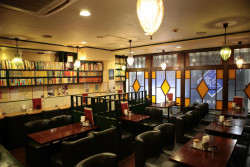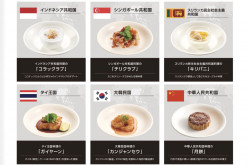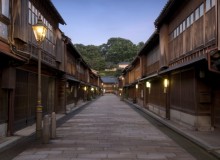
Originally published on metropolis.co.jp on November 2013



Melon-flavored ice cream from Hokkaido. Natamame (sword bean) tea from Hyogo. Mikan juice from Wakayama. Usually such unique regional items can only be savored by visiting the prefecture or city they are from, often two or more hours by bullet train or plane from Tokyo.
Yet for those who crave food adventures or want to taste a particular fruit from Okinawa again, antenna shops are the answer. Small government shops representing all 47 of Japan’s prefectures, they provide a culinary and cultural glimpse into the unique delights of even the most far-flung of the archipelago’s regions. Created as a way to promote tourism and serve as an outlet for regional products and produce, the shops often also host reasonably priced cafés where visitors can sample scrumptious regional fare.
Ginza Washita, the Okinawa antenna shop in the expensive area, opened its doors in 1994 to become the city’s first permanent shop. (Other organizations had previously run short “fairs” such as one held in the Marunouchi department store near Tokyo station in 1933 to showcase regional specialties.) Kagoshima followed suit in 1995, and based on the success of those stores, other prefectures established their own. Governor of Miyazaki Prefecture and former comedian, Hideo Higashikokubaru, led a public relations campaign in 2008 that boosted awareness of the region and helped popularize its antenna shop in Shinjuku. According to the Japan Center for Regional Development, a government agency that helps organize the satellite stores, this resulted in an antenna shop boom. A total of 55 shops can now be found in Shinjuku, Yurakacho and Ginza alone. The most recent one opened at the Tokyo Sky Tree.

“Most of our visitors come from Tokyo, Chiba or Saitama. Maybe they lived in Toyama or they traveled there, and they want to find those items peculiar to Toyama. It’s a very natural lifestyle there, much different than Tokyo,” said Seiichi Yamauchi, who moved from Toyama to manage Iki Iki Toyamakan. Here, shoppers wait in line for ichiyaboshi (quick-dried salted fish) and lingered over boxes of masuzushi, thinly sliced salmon on rice wrapped in bamboo leaves. The shop also hosts regular craft classes and publishes a calendar of Toyama’s seasonal fruits. “It’s a way for Toyama people to show others where they are from,” he added.
Yukari Sakamoto, author of Food, Sake, Tokyo, finds antenna shops a treasure trove of culinary delights. “I love exploring the depth of ingredients, from pickles to miso to sake. I’ve had the great fortune of traveling through many parts of Japan, so it’s fun to find unique ingredients from past trips,” she said.
Shop items usually include a mix of fresh, frozen and dried foods, as well as beverages like sake, shochu and juices, along with unique products such as hechima (loofah) sponges from Toyama or lavender bath salts from Hokkaido. Most shops receive shipments of fresh fruits and vegetables twice a week to reflect their respective growing seasons. The Yamagata shop, for example, offers sansai (mountain vegetables) in spring while Ehime has a range of citrus throughout the winter months. Fresh sweet corn can hardly be kept in stock at the Hokkaido Dosanko Plaza in Yurakacho, and ice cream is always a favorite, according to manager Sadayuki Ishikawa.
“We have over 1,000 different items here, but the soft serve ice cream is easily our best seller,” he said, gesturing to a line ten people deep. “Vanilla, melon and melon-mix,” he added as we watched customers of all ages enjoying their cones.

Sakamoto offers small group tours of antenna shops and her guests are astounded to discover the vast scope of Japanese food. “Visitors love it as they can see the diversity of Japanese cuisine when visiting several areas in a short period,” she says. One quickly understands the tropical climate of Okinawa compared to the northern island of Hokkaido and its rich seafood and dairy products. Then a visit to the Tokushima-Kagawa shop shows how udon is a big part of that region.”
“Antenna shops are an open window to provincial Japan,” says Lionel Dersot, who also leads guided tours of the shops. “They are a way to get past standardized food, to remember that there is life beyond that.”
Sakamoto’s antenna shop passion started a handful of years ago when a friend told her about Ginza Washita. “We were talking about awamori, the Okinawan shochu made from Thai rice and black koji (a rice-grown mold used to make sake). The Ginza Washita shop has a huge selection of awamori. There is also a nice choice of colorful Ryukyu-style glasses for drinking it,” effused Sakamoto, a trained sommelier.

When Dersot began cooking more, he began paying attention to what he says had been in front of him all the time. “The more you cook, the more you are interested in things. I cook which means that I buy food. And when you buy food, you learn things. You think in terms of money but also in terms of variety. And you discover things.”
Antenna shops present an interesting alternative to supermarkets.

“I prefer antenna shops that offer fresh food. Antenna shops offer many of the things someone might bring back as omiyage (presents), but there are many things you won’t bring back. For example, red leeks from Kumamoto. If you go to the Kumamoto antenna shop, you will find interesting produce. You can find them at upscale department stores but not in the standard supermarket and not at such a reasonable price.”
The government isn’t the only group that thinks the antenna shop concept is a good idea. Kenmei Nagaoka, founder of D & Department Project in Tokyo, aims to create an experience for visitors that encourages travel. To that end, he created a bi-lingual magazine, D Design Travel, which is published three times a year with each issue focused on one prefecture and then rented space in Shibuya’s Hikarie building. There on the 8th floor, visitors will find d47 Shoukudo, a restaurant featuring seasonal regional dishes, sakes, juices and teas from each of Japan’s 47 prefectures. Across from the restaurant is a workshop space where D & Department organizes talks and hands-on workshops in regional crafts or cooking. A gallery space just around the corner often exhibits products from the prefectures or zeroes in on a specific region. Each piece is designed to support the other, to inspire visitors to explore and begin to understand what is special about a region.
“We want them to come here, taste this food, read this magazine, see that item and then want to go. We want them to go and experience the reality of that place,” said Yuko Konoto, public relations officer for D & Department.
The idea has also been harnessed by smaller cities. Koganeya is a little shop that sells only products produced in this western Tokyo suburb. Started in 2011 by Koganei’s Chamber of Commerce, the shop has proven to be a big hit with nearly 200 visitors a day. Vegetables, eggs, soap, baked goods, soba and udon from nearly 70 local businesses, including nine farms, can be found. A charming café on the second floor uses local seasonal ingredients for their lunch sets and desserts. “People like being able to buy local items and many different things in one place,” said Eriko Shimomura, a clerk at the store.
Koganeya’s most popular item is Ohori farm’s sakura honey. Located next door to Koganei Park, home to nearly 2,000 sakura (cherry trees), their bees find plenty to keep them busy each spring. “The sakura honey has a fresh grassy smell that customers love,” said Shimomura. Local flavor at its best.
Hokkaido Dosanko Plaza
Located on the ground floor of the Tokyo Kotsu Kaikan building and less than two minutes from the station, visitors will find Hokkaido’s famous dairy products, fish, assorted seaweeds, snacks and, of course, some of the best ice cream around. Nearest stn: Yurakucho. Open daily, 10am-7pm. http://www.dosanko-plaza.jp
Iki Iki Toyama
Head to the basement of the Tokyo Kotsu Kaikan building only a few steps from the station and discover the delights of Japan’s west coast. Fish, sake, rice and noodles are just a few things available. An on-site sushi master will whip up whatever seasonal specialty the prefecture has to offer.Nearest stn: Yurakucho. Open daily, 10am-7pm. http://toyamakan.jp
Koganeya
Head out the south exit to this very local antenna shop featuring fresh, seasonal produce delivered daily, including a selection of Edo yasai (vegetables) throughout the year. A second floor café whips up yummy lunch sets from local ingredients as well as a nice selection of desserts. Nearest stn: Higashi-Koganei. Tue-Fri, 10am-8pm. http://toyamakan.jp/
Kumamotokan
Visitors to either of these antenna shops will find a nice variety of fresh fruits and vegetables, local sweets and karashi renkon (mustard stuffed lotus root). Fish, horsemeat, sake, shochu and charcoal bathing products are also available. Don’t forget to say hello to Kumamon, the black and white bear that is the prefecture’s mascot, too.Nearest stn: Ginza or Kichijoji. Open daily, 10am-7pm. http://www.kumamotokan.or.jp
Washita Ginza
A 15-minute walk from the station leads to Okinawa. With an interior designed to look and feel like a traditional island building, visitors will find an excellent selection of fresh produce, awamori, and crafts. The Okinawan music selection, according to Sakamoto, is terrific, too. Nearest stn: Onoyamakoen. Open daily, 10am-7pm. http://www.washita.co.jp/info/shop/ginza







